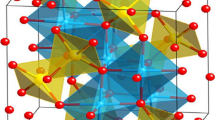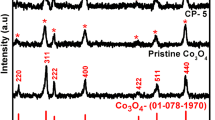Abstract
Hybrid supercapacitors have gained upsurge interest in the energy storage application, but still have room to improve their specific power and energy limits with the implication of electrode materials that have superior electrochemical performance. Herein, we study the synergistic effect of the synthesized cobalt sulfide (CoS) along with manganese sulfide (MnS). The electrochemical outcomes were analyzed in three-electrode cell configuration. The cobalt manganese sulfide (CoS/MnS) composite demonstrates considerable better performance having specific capacity of 590.3 C g−1 (3 mV s−1) and 501.3 C g−1 (1.0 A g−1). The CoS/MnS electrode was further employed as a positive electrode material in a hybrid supercapacitor (supercapattery) along with activated carbon (negative electrode). The device delivers an energy density of 46 Wh kg−1 and holds a power density of 1705 W kg−1. Further, the hybrid device also retains a remarkable specific capacity of 94.57% after 1,000 continuous charging–discharging cycles at 3 A g−1. The semi-empirical approach was employed to further investigate the hybrid nature of the device, which separates the diffusive and capacitive contributions in experimental cyclic voltammetry. These results demonstrate CoS/MnS composite may have a promising implication as an electrode material for high-performance energy storage applications.










Similar content being viewed by others
References
Babu IM, William JJ, Muralidharan G (2019) Hierarchical β-Co(OH)2/CoO nanosheets: an additive-free synthesis approach for supercapattery applications. Ionics 25(5):2437–2444
Li Z et al (2018) Controlled synthesis of Ni(OH)2/MoS2 nanohybrids for high-performance supercapacitors. Mater Chem Phys 209:291–297
Arunpandiyan S et al (2022) Significance of redox additive electrolyte over energy and power densities of mixed metal vanadate-based supercapattery device. ACS Appl Electron Mater 4(12):5884–5892
Padmanathan N et al (2016) Hierarchical NiO–In2O3 microflower (3D)/nanorod (1D) hetero-architecture as a supercapattery electrode with excellent cyclic stability. J Mater Chem A 4(13):4820–4830
Iqbal MZ, Zakar SSHS, Alzaid M (2021) Superior performance of cobalt oxide/carbon composite for solid-state supercapattery devices. Physica B 603:412561
Iqbal MZ et al (2021) Synergestic effect of magnetron sputtered silver nano-islands and Co3(PO4)2 for high performance supercapattery devices. J Electroanal Chem 898:115612
Peng X et al (2018) Facile synthesis of cost-effective Ni3(PO4)2· 8H2O microstructures as a supercapattery electrode material. Mater Today Energy 7:129–135
Alam S, Iqbal MZ, Khan J (2021) Green synthesis of nickel-manganese/polyaniline-based ternary composites for high-performance supercapattery devices. Int J Energy Res 45(7):11109–11122
Lin J et al (2019) Designing and constructing core-shell NiCo2S4@Ni3S2 on Ni foam by facile one-step strategy as advanced battery-type electrodes for supercapattery. J Colloid Interface Sci 536:456–462
Iqbal MZ et al (2022) Exploring the synergy of binder free MoWS2@ Ag as electrode materials for hybrid supercapacitors. J Energy Storage 56:105925
Rantho MN, Madito MJ, Manyala N (2018) Symmetric supercapacitor with supercapattery behavior based on carbonized iron cations adsorbed onto polyaniline. Electrochim Acta 262:82–96
Kelley, S.C., Silicon micro-fabricated miniature polymer electrolyte fuel cells. 2000: University of Minnesota
Lee DU et al (2016) Self-assembled NiO/Ni(OH)2 nanoflakes as active material for high-power and high-energy hybrid rechargeable battery. Nano Lett 16(3):1794–1802
Iqbal MZ, Aziz U (2022) Supercapattery: merging of battery-supercapacitor electrodes for hybrid energy storage devices. J Energy Storage 46:103823
Verma KD et al (2020) Characteristics of electrode materials for supercapacitors. Handbook of nanocomposite supercapacitor materials i: characteristics. Springer, pp 269–285
Iqbal MZ, Khan J (2021) Optimization of cobalt-manganese binary sulfide for high performance supercapattery devices. Electrochim Acta 368:137529
Han P et al (2018) Lithium ion capacitors in organic electrolyte system: scientific problems, material development, and key technologies. Adv Energy Mater 8(26):1801243
Anjos DM et al (2013) Pseudocapacitance and performance stability of quinone-coated carbon onions. Nano Energy 2(5):702–712
Noked M, Soffer A, Aurbach D (2011) The electrochemistry of activated carbonaceous materials: past, present, and future. J Solid State Electrochem 15:1563–1578
Gcilitshana, O.U., Supercapacitor electrode materials based on nanostructured conducting polymers and metal oxides. 2013.
Ansari M, Nordin NA (2021) Supercapattery: technical challenges and future prospects. Advances in Supercapacitor and Supercapattery, Elsevier Amsterdam p, pp 349–377
Iqbal MZ, Faisal MM, Ali SR (2021) Integration of supercapacitors and batteries towards high-performance hybrid energy storage devices. Int J Energy Res 45(2):1449–1479
Iqbal MZ et al (2020) Cobalt–manganese-zinc ternary phosphate for high performance supercapattery devices. Dalton Trans 49(46):16715–16727
Iqbal MZ et al (2021) Optimizing electrochemical performance of sonochemically and hydrothermally synthesized cobalt phosphate for supercapattery devices. Int J Hydrogen Energy 46(29):15807–15819
Gao M-R et al (2013) Nanostructured metal chalcogenides: synthesis, modification, and applications in energy conversion and storage devices. Chem Soc Rev 42(7):2986–3017
Zhou Y et al (2019) Chemical precipitation synthesis of porous Ni2P2O7 nanowires for supercapacitor. J Alloy Compd 790:36–41
Meng X et al (2017) Solvothermal synthesis of cobalt/nickel layered double hydroxides for energy storage devices. J Alloy Compd 695:3522–3529
Nasuha S et al (2022) Manganese-doped zinc sulfide binary nanostructures as binder-free electrode materials for supercapattery. J Solid State Electrochem 26(8):1733–1746
Iqbal MZ et al (2022) Reduced graphene oxide/cobalt phosphate composites with improved electrochemical performance for supercapattery devices. Int J Energy Res 46(15):23377–23387
Tarimo DJ et al (2020) Enhanced electrochemical performance of supercapattery derived from sulphur-reduced graphene oxide/cobalt oxide composite and activated carbon from peanut shells. Int J Hydrogen Energy 45(58):33059–33075
Liu W et al (2018) Ternary transition metal sulfides embedded in graphene nanosheets as both the anode and cathode for high-performance asymmetric supercapacitors. Chem Mater 30(3):1055–1068
Mi L et al (2014) Beneficial metal ion insertion into dandelion-like MnS with enhanced catalytic performance and genetic morphology. RSC Adv 4(37):19257–19265
Omar FS et al (2017) A promising binary nanocomposite of zinc cobaltite intercalated with polyaniline for supercapacitor and hydrazine sensor. J Alloy Compd 716:96–105
Brousse T, Bélanger D, Long JW (2015) To Be or Not To Be Pseudocapacitive? J Electrochem Soc 162(5):A5185–A5185
Li L et al (2017) Ultrathin petal-like NiAl layered double oxide/sulfide composites as an advanced electrode for high-performance asymmetric supercapacitors. J Mater Chem A 5(37):19687–19696
Numan A et al (2017) Sonochemical synthesis of nanostructured nickel hydroxide as an electrode material for improved electrochemical energy storage application. Prog Nat Sci: Mater Int 27(4):416–423
Omar FS et al (2017) Binary composite of polyaniline/copper cobaltite for high performance asymmetric supercapacitor application. Electrochim Acta 227:41–48
Iqbal MZ et al (2020) Capacitive and diffusion-controlled mechanism of strontium oxide based symmetric and asymmetric devices. J Energy Storage 27:101056
Li L et al (2017) Ultrathin petal-like NiAl layered double oxide/sulfide composites as an advanced electrode for high-performance asymmetric supercapacitors. J Mater Chem A 5(37):19687–19696
Yu X, Lu B, Xu ZJAM (2014) Super long-life supercapacitors based on the construction of nanohoneycomb-like strongly coupled CoMoO4–3D graphene hybrid electrodes. Adv Mater 26(7):1044–1051
Qu R et al (2018) Antioil Ag3PO4 nanoparticle/polydopamine/Al2O3 sandwich structure for complex wastewater treatment: dynamic catalysis under natural light. ACS Sustain Chem Eng 6(6):8019–8028
Gao X et al (2019) Morphology-controllable preparation of NiFe2O4 as high performance electrode material for supercapacitor. Electrochimica Acta 296:181–189
Zhang J et al (2015) Solvothermal synthesis of three-dimensional hierarchical CuS microspheres from a Cu-based ionic liquid precursor for high-performance asymmetric supercapacitors. ACS Appl Mater Interfaces 7(39):21735–21744
Xie T et al (2018) Self-supporting CuCo2S4 microspheres for high-performance flexible asymmetric solid-state supercapacitors. Eur J Inorg Chem 2018(43):4711–4719
Dai C-S et al (2013) Hierarchically structured Ni3S2/carbon nanotube composites as high performance cathode materials for asymmetric supercapacitors. ACS Appl Mater Interfaces 5(22):12168–12174
Tang Y et al (2014) Morphology controlled synthesis of monodisperse cobalt hydroxide for supercapacitor with high performance and long cycle life. J Power Sources 256:160–169
Acknowledgements
The authors are grateful to the researchers supporting project number (RSPD2023R669), King Saud University, Riyadh, Saudi Arabia.
Author information
Authors and Affiliations
Contributions
MZI was involved in supervision, conceptualization, formal analysis, writing — review and editing. AA contributed to writing draft. JK was involved in material characterizations. SA contributed to material characterizations. AAl contributed to funding acquisition and formal analysis. SA and MZA were involved in visualization and formal analysis.
Corresponding authors
Ethics declarations
Conflict of interest
The authors declare that they have no known competing financial interests or personal relationships that could have appeared to influence the work reported in this paper.
Additional information
Handling Editor: Jean-Francois Gohy.
Publisher's Note
Springer Nature remains neutral with regard to jurisdictional claims in published maps and institutional affiliations.
Rights and permissions
Springer Nature or its licensor (e.g. a society or other partner) holds exclusive rights to this article under a publishing agreement with the author(s) or other rightsholder(s); author self-archiving of the accepted manuscript version of this article is solely governed by the terms of such publishing agreement and applicable law.
About this article
Cite this article
Iqbal, M.Z., Ahmed, A., Khan, J. et al. Exploring the electrochemical potential of redox-active mixed metal sulfide as an efficient electrode material for supercapacitor-battery hybrid. J Mater Sci 58, 14109–14120 (2023). https://doi.org/10.1007/s10853-023-08890-w
Received:
Accepted:
Published:
Issue Date:
DOI: https://doi.org/10.1007/s10853-023-08890-w




